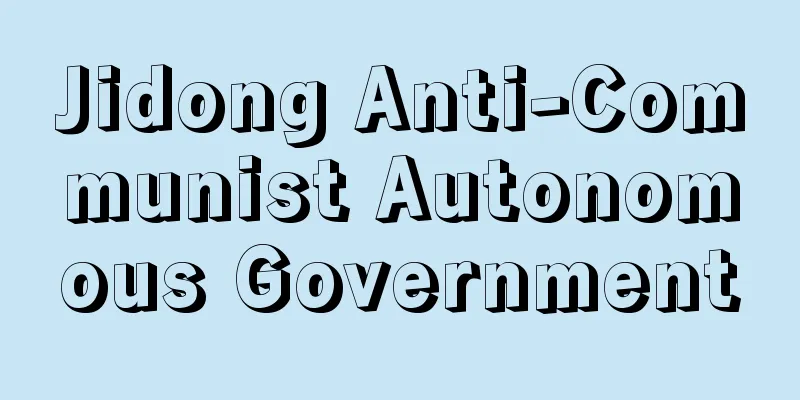Jidong Anti-Communist Autonomous Government

|
A Japanese puppet government in the eastern part of Hebei Province, China, from 1935 to 1938. Ji is an abbreviation of Hebei Province. In November 1935, Yin Rugong (Yin Rugong) allied with the Japanese Kwantung Army and advocated secession from the central government, and declared the establishment of the Jidong Anti-Communist Autonomous Committee, which governed the 22 counties of Jidong and the 3 counties of Chahar Province. In December of the same year, it was renamed the Jidong Anti-Communist Autonomous Government and Yin became its Chief Minister. It governed the 22 counties of Jidong, covering an area of 8,200 km2 with a population of 6.28 million, and its capital was Tongzhou. Since 1935, Japan had been smuggling opium and other goods in this area, drawing criticism from the Nanjing Nationalist Government, but in February 1936, the Jidong Government designated four ports for imports into Japan, and decided to collect inspection fees equivalent to one-quarter of the central government's customs duties from May. This was the Jidong trade, and the conflict with the Nanjing Nationalist government deepened. However, by 1937, the amount of Jidong trade had dropped sharply, and a compromise was reached in which the Nanjing government would remit 1 million yuan per month to the Jidong region and abolish the Jidong trade. The autonomous government's activities only strengthened the anti-Japanese sentiment among the security forces' officers and soldiers, and when the Sino-Japanese war escalated in earnest following the Marco Polo Bridge incident in July 1937, the security forces rebelled in Tongzhou, killing about 200 Japanese residents (the Tongzhou incident). The government then moved to Tangshan, with Chi Zongmo as governor, but by the end of the same year the Jidong trade was also abolished, and in February of the following year, 1938, the government merged with the Nationalist government in Beijing, dissolving the government. Source : Heibonsha Encyclopedia About MyPedia Information |
|
1935年―1938年,中国河北省東部にあった日本の傀儡(かいらい)政権。冀は河北省の略。1935年11月に殷汝耕(いんじょこう)が日本の関東軍と結んで中央離脱をとなえ,冀東22県と察(チャハル省)3県を管轄する冀東防共自治委員会の樹立を宣言,同年12月に冀東防共自治政府と改称して政務長官の地位についた。管轄は冀東22県として面積8200km2,人口628万人を数え,首都は通州。1935年より日本はこの方面でアヘンなどの密輸を行って南京国民政府の非難をあびてきたが,1936年2月,冀東政府が対日輸入港4港を指定して,5月からは中央の関税の4分の1にあたる査験料を徴収することとした。これが冀東貿易で,南京国民政府との対立はさらに深まった。しかし1937年には冀東貿易額は激減,結局,南京政府が冀察方面に毎月100万元を送金することで冀東貿易を廃止するとの妥協に達した。自治政府の活動はかえって保安隊将官・兵士の抗日化を強める結果となり,1937年7月の盧溝橋事件をきっかけに日中戦争が全面化すると通州で保安隊の反乱が起きて在留日本人約200人が殺された(通州事件)。こののち政府は唐山に移って池宗墨が長官となったが,同年末には冀東貿易も廃止され,翌1938年2月政府も北京の国民政府に合流して解消した。
出典 株式会社平凡社百科事典マイペディアについて 情報 |
<<: Balanoposthitis - Inflammation of the balanoposthitis
>>: Orbital platform - Kidou platform (English spelling) space platform
Recommend
Obe - Obe
...The Ama use glasses and weights when diving, b...
Vecia cracca (English spelling) Veciacracca
…【Hoshikawa Kiyochika】. … *Some of the terminolog...
Eliza Orzeszkowa
1841‐1910 A representative Polish positivist novel...
Large drift net fishing - Omenagashiamigyoyo
...The hauling of nets begins at around 1 or 2 am...
The Adventures of Auggie March
...Both his first novel and his second work, The ...
Guardian - Shugo
In medieval Japan, a warrior or organization that...
"Ode to the Epang Palace"
…He was a Jinshi (official scholar) in the second...
Kakemamori - guardian
Amulets are worn around the neck to protect onese...
Land Revolution War - The Near Eastern War (English:
A modern Chinese revolutionary movement that aims ...
Bodhi-vrksa (English spelling) Bodhivrksa
...A deciduous tall tree of the Tilia family (ill...
Spherical bar gauge
...the end surface is either flat, cylindrical, o...
Utou-setsumon
…In China, a gate with two pillars connected at t...
Cypselurus atrisignis (English spelling) Cypselurusatrisignis
…[Isao Hanyu]. … *Some of the terminology that me...
Yukinobu Kiyohara
Years of birth: unknown. Painter of the early Edo ...
Raw skin - Namahage
This is a folk event (nationally designated Import...









